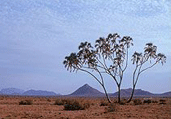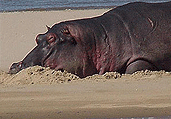In the arid
North of Kenya, water means life. The waters of the great Ewaso
Nyiro River draw wildlife in great numbers to its banks, creating
an oasis of green. This river flows through three great northern
reserves, Samburu, Buffalo Springs and Shaba. This is spectacular
country, set against a backdrop of the mighty Mountain Ol Olokwe.
The complex formed by Samburu, Buffalo Springs and Shaba reserves
is one of the most interesting places in Kenya and can be ranked
as unique for several reasons. A safari through Samburu, Buffalo
Springs and Shaba is a rich and rewarding experience. Travelling
along the banks of the Ewaso N'giro provides a fascinating procession
of varied species. Elephant come to the river to drink, and in the
dry season, use their tusks to dig deep wells in the dry river beds.These
elephant excavations then become a focal point for other plains
game and troops of baboon, attracted by the fresh water supply.
The surrounding riverine forests are good birding country, and in
the late afternoon also excellent leopard territory. Several individual
leopards are commonly seen in trees around the river each day.
They are the most accessible and visited of the protected areas
in the country's rough north, right at the edge of Northern Frontier
District. Or, in other words, they are the most remote and inaccessible
among the most popular reserves. It is also the place to see some
species which are rare in Kenya or difficult to spot in other
parks, since they only dwell above the Equator. Among them are
Grevy's zebra, reticulated giraffe and Beisa Oryx.
Samburu and Buffalo Springs are adjacent reserves, separated solely
by a river. Initially, Buffalo Springs covered both banks of the
Ewaso Nyiro river (Uaso Ngiro, "Dark Waters") along
16 km, but later on, the north bank was torn apart as an independent
reserve, since this area belongs to the Samburu District ("butterfly"
in the Maa language) and the south side is under the jurisdiction
of Isiolo District, to which Shaba also belongs. The latter district
belongs to the Eastern Province, whereas Samburu District is located
in the Rift Valley Province. Shaba, the less visited of the three,
is also the largest, with a total extension of 239 km². Samburu
and Buffalo Springs are similar in surface, 165 km² the first
and 128 km² the second. The area has been traditionally inhabited
by the Samburu people, a nomad paranilotic tribe closely related
to the Maasai.
The Samburu complex landscape preludes what the traveller should
expect if he sets his feet for the northern territories, hence
its classical "frontier" epithet: arid thornbush savannah,
scrubland and scattered acacia. The dusty plains are broken by
smooth hills, outstanding the Koitogorr uplift in Samburu (1,245
m) and, lying far beyond, the flat head of the reddish Ol Olokwe
Mountain. The extreme heat, in spite of the altitude many times
above 1,000 m, and the landscape desolation, are paramount ingredients
of Samburu's particular charm: it is the face of the less hospitable
Africa, maybe hence prouder. At first sight, these reserves could
suggest a wildlife desert. Actually, this arid scrub is the preferred
habitat for some mammals well adapted to this harsh and unfriendly
environment, some of them quite rarely seen in milder climates.
It is true though that the bulk of wildlife gathers around the
scarce wet areas, mainly the forested banks of the Ewaso Nyiro,
which brings the Aberdare waters, and the crystal clear Buffalo
Springs, at the eastern side of this reserve, which are formed
by the arise of underground streams coming from Mount Kenya. The
humid spots give rise to more luxuriant vegetation, with the prehistorical
- looking bi-branched doum palms, riverine forests and grasslands.
The high faunal concentration at the waterholes and streams is
a gift for the wildlife watcher, while animals also seem to amuse
themselves staring at the tourists dipping in one of the Buffalo
Springs pools, which is conditioned for bathing.
Beyond Samburu and Buffalo Springs, the river heads on licking
Shaba's north border. This place takes its name from a volcanic
cone that rises upon the plain and whose lava flow is crossed
when accessing the lodge. Beyond Shaba, the river wanders about
down to Chanler's fall, to finally die in the Lorian Swamp. Shaba's
landscape is seeded with low hills and its four natural springs
confer a much higher wetness level than its neighbouring reserves,
to such an extent that during the rains, Shaba's tracks are only
open to 4WD vehicles. In general, the reserve is less developed
and is therefore more peaceful and solitary than its sisters.
Shaba is known for being the place where in 1980 poachers murdered
Joy Adamson, authoress of "Born free". At the time of
her death, the famous conservationist was engaged in a project
aimed at reinserting hand-reared leopards to the natural environment.
In these reserves it is easy to find some of the species that
live only above the Equator and that therefore you will very hardly
spot in southern parks. Among them, outstands the Grevy's zebra,
distinguished from its plains' relative by narrower stripes and
big rounded ears. Oddly enough, some plains' zebras (Burchell)
are also found mainly at the south banks, in Buffalo Springs,
but they do not seem to interbreed with their Grevy's cousins.
The Beisa oryx is a beautiful grey antelope, with black and white
marks in the face and long horns in both sexes. The reticulated
giraffe, with no mistake the most gorgeous in the family, is easily
distinguished by its particular coat, a thin and clear white net
splitting the orange spots. Another remarkable inhabitant of these
reserves is the gerenuk, a slender antelope with thin neck and
long legs that drinks no water and feeds on the acacia's leaves,
supporting its body on the hind legs.
Samburu and Buffalo Springs host basically two different environments
for wildlife observation. The first one holds all the arid plains,
far off the water sources. Relatively few animals inhabit these
lands on a permanent basis, outstanding the oryx, Guenther's dik-dik
(in addition to the more widely extended Kirk's), gerenuk, eland
and impala. These species are little water-dependent and may be
found in the scrublands during the day, sheltered beneath a tree
shade. Conversely, the rest of herbivores, including zebra, giraffe,
elephant, buffalo, warthog, waterbuck, Grant's gazelle and bushbuck
seek the fresh and shaded riverbanks during daylight, leaving
them at dusk. The great advantage for the watcher in Samburu and
Buffalo Springs is that driving along the river gives the chance
to see a huge lot of animals close at hand. Waters welcome their
permanent dwellers, hippos and crocodiles, while up its big trees
and doum palms roam the vervet monkeys and baboons.
Carnivores are well represented in the Samburu complex. Lions
and cheetah traverse the dry areas and seek the shaded riverine
forest for a drink and a rest. Hyenas, including the striped of
nocturnal habits, travel long distances with their light trotting.
But one of the reasons that has made these reserves so popular
is the real good possibilities to catch a sight of the leopards,
much more probably than in any other Kenyan park. These felines
are found elsewhere, but their taste for the high branches helps
them to pass unnoticed most of the times. Here, leopards rest
and kill by night at the Ewaso Nyiro banks. An early morning drive,
when the cats are still active, has a great chance of reward.
The three reserves are also the haunt for a rich avifauna, with
more than 300 species recorded. This is the place for the Somali
ostrich, with its bluish neck and thighs, and for the Kori bustard,
standing a meter high. The scrublands are home for some game birds,
like crested francolins, yellow-necked spurfowls and the Guineafowls,
both vulturine and helmeted that actually belong to different
genuses and that flock to drink down at the river banks. Red-billed
hornbills, marabou storks and superb starlings are a permanent
presence. Prey birds include eagles, owls, kites, goshawks and
sparrowhawks. Woodpeckers nest in the riverine trees. The Ewaso
Nyiro waters attract a great deal of water birds, like pelicans,
herons, hamerkops and kingfishers.
Finally, in some sandy soils hollow their tunnels the naked mole
rats, rare and small mammals devoid of hair, with a social behaviour
similar to colonial insects and whose presence is detected through
the mounts which betray their burrows, expelling pulsatile sand
puffs like miniature geysers.






